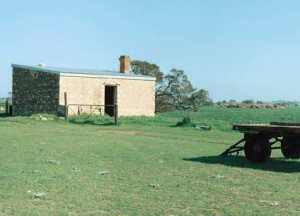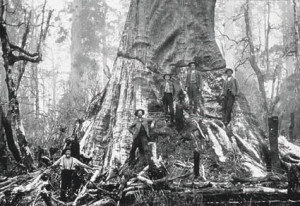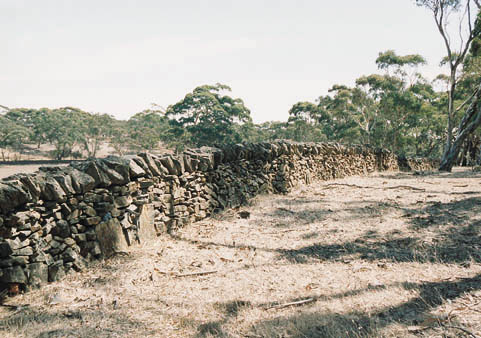Australia is a very large continent. It has a total surface area of 7.6 million km2 and is surrounded by an ocean territory of 16.1 million km2 including its exclusive economic zone and claimable continental shelf. Australia is a very ‘old’ continent geologically. It is the driest of the world’s inhabited continents, with the lowest percentage of rainfall as run-off, the lowest amount of water in rivers and the smallest area of permanent wetlands. More than half of the Australian continent is made up of a peneplain, an extremely large level area constituting most of Western Australia, Northern Territory and western South Australia. This area is poorly and variably supplied with rainfall and has always been sparsely populated.
The original indigenous inhabitants of Australia lived as ‘hunter-gatherers’ on native plants and animals. Their principal land management tool was the selective use of fire. They were joined from 1788 by the Europeans, settling over time in separate colonies centred on Sydney, Hobart, Perth, Adelaide, Melbourne and Brisbane. These immigrants brought with them their northern hemisphere agricultural practices of cultivating the soil; growing grain, fruit and vegetable crops; and rearing animals. The new arrivals saw the continent as an unallocated resource ripe for development that would be based on previous European experience, albeit at least initially recognising the presence and needs of the indigenous inhabitants.
However, some lessons for improved natural resource management were brought from Europe. Even in the early days of settlement, some important decisions made by surveyors showed an appreciation of natural resource management and the need to avoid private ownership of key natural resources. The littoral environment, some riparian and most estuarine shores and various scenic points, for example, were retained in public ownership.

Australia was soon self-reliant in food production and agricultural exports to Britain and Europe began around 1811. Grain exports using sailing ships were well established by the 1870s. However, interacting factors such as the opportunity to replace native vegetation and animals with introduced crop species and domesticated livestock, and the introduction of exotic plant and animal pests have had a major impact on land use and consequently on the condition of land, water and marine resources. The progressive development of mining, ports and urban areas, particularly following from the gold rush finds of the 1850s, created specific impacts on land resources in localised areas.
Commonwealth, State and Territory governments
The federation of the Australian colonies in 1901 was a defining event in natural resource management. The Commonwealth of Australia Constitution Act 1900 (Imp.) provides for the Commonwealth to have powers for trade and commerce with other countries and among the States [s 51 (i)] and external affairs [s 51 (xxix)], while section 107 inter alia provides for powers previously vested in colonies to continue with the States unless specifically vested in the Parliament of the Commonwealth. Section 107 also precludes the Commonwealth from abridging the right of a State or its residents therein to the reasonable use of the waters of rivers for conservation or irrigation. In essence, this left natural resource management responsibilities—excluding Commonwealth waters—with the States, but as the Commonwealth has since ratified various international treaties relating to environment, conservation and heritage, (thirty-nine by 1996 [State of Environment Advisory Council 1996]), there has been an increasing constitutional basis for Commonwealth involvement in land management issues.
With development, increasing interaction occurred between Commonwealth and State governments on the use of natural resources. The Commonwealth assumed responsibility for the Northern Territory from South Australia on 1 January 1911. In 1915, the Commonwealth, New South Wales, Victoria and South Australia had passed Acts of Parliament ratifying the River Murray Waters Agreement, leading to the establishment of the River Murray Commission in 1917. By 1934, the Federal and State Ministers of Agriculture had established Australian Agricultural Council, with a subordinate Standing Committee on Agriculture made up of the heads of Commonwealth and State agencies responsible for agriculture, together with CSIRO and the Commonwealth Department of Health. Later Ministerial Councils and Standing Committees included those for soil conservation, land information, water resources, conservation, forestry, fisheries and environment protection. The Northern Territory achieved self-government in 1978 and the Australian Capital Territory in 1988, with both becoming full members of the Ministerial Councils. Within the last decade there has been an increasing overlap and integration of Ministerial Council activities including:
initially the formation of the Agricultural and Resource Management Council of Australia and New Zealand and the Australian and New Zealand Environment and Conservation Council;
their subsequent replacement by the Natural Resources Management Ministerial Council and Standing Committee; and
Primary Industries Ministerial Council and the Environment Protection and Heritage Ministerial Council with their respective Standing Committees in 2001.
Figure 1. Relationship of Ministerial Councils and their main subordinate bodies to Council of Australian Governments.
Figure 1. Relationship of Ministerial Councils and their main subordinate bodies to Council of Australian Governments.
Arrangements were set in place to ensure effective cross-linkages between these (Figure 1). These Standing Committee structures and activities reflect a broad recognition of both the importance of partnerships and the effectiveness of undertaking many activities in an Australia-wide context.
Appreciating the limits of natural resources
The limits of the world’s natural resources have been the subject of debate for hundreds of years. The prospect of resources constraints was given prominence by Malthus (1798). In more recent times, the Club of Rome’s report The Limits to Growth (Meadows et al. 1972) predicated its study on a belief that the basic behaviour mode of the world system is exponential growth of population and capital, followed by collapse.
Australia has been mapped into agro-ecological zones (Figure 2), but only 25% of the continent has a growing season of more than five months. The area with a growing season of more than nine months—generally recognised as required for long season annual crops and perennial crops—is a mere 9% of the continent. Only 6% of Australian is considered arable. The more highly productive lands, often described as the ‘intensive land use zone’, are located along the eastern and south-eastern seaboard and in the south-western corner of the continent.
Figure 2. Australia’s agro-ecological zones
Figure 2. Australia’s agro-ecological zones.
Australia has a mosaic of land use that is continuing to evolve (Figure 3).
Land continued to be brought under cultivation for agriculture steadily until the 1960s, often encouraged by government incentives, and, even today, a limited amount of continuing land development is taking place through clearing of native vegetation. Considerable development is also taking place on previously established farming land through changing use patterns and intensification.
The twentieth century also saw a major expansion in land used for extraction of mineral and energy resources.
Conservation reserves have been progressively increased and now take up a little over 5% of land area.
Public lands accessible for harvesting of native timber have declined as increased areas have been reserved for nature conservation. The current 4.8% of land in forestry is increasingly based on private plantation and farm forestry production systems.
Following the passage of the Aboriginal Land Rights (Northern Territory) Act 1976 (Cwlth), significant areas have been set aside for indigenous use. Aspects of land management were further clarified in the Native Title Act 1993 (Cwlth). This Act recognises and protects native title, recognises pre-existing rights and interest of Indigenous peoples to land and waters, and establishes ways in which dealings affecting native title may proceed. The legislation was amended in 1998 to provide for alternative State-based regimes.

Figure 3. Australia’s broad, dominant land use categories.
Figure 3. Australia’s broad, dominant land use categories.
Australia has a developed, multi-faceted economy. Agriculture continues to be an important contributor to national, State/Territory and regional economies. Including pastoralism, it remains Australia’s most extensive form of land use, taking up to 60% of the country’s area. With an annual gross value of production at farm gate averaging $25 billion, and exports of $17.6 billion in the period 1989-1999, agriculture represented about 3% of the average annual gross domestic product ($620 billion in that period). Other sectors of the economy, particularly in regional areas, remain highly dependent on the farm sector. Approximately 60% of manufacturing turnover in the Murray-Darling Basin, for example, is derived from food processing industries.
Agricultural exports represent 20% of Australia’s total exports. By comparison, crude and processed mineral production, derived from quite small areas (including some off-shore), makes up approximately 35% of exports with a value of approximately $35 billion. The annual gross value of tourism—often related to Australia’s land and its diversity of natural resources although little of the expenditure relates to natural resource management—is about $25 billion (with approximately 70% generated by domestic households). Tourism represents around 4.5% of Australia’s gross domestic product with international visitors representing 11.2% of export earnings in 1997/98.
By the 1980s, Australia began to recognise that new land could no longer be ‘developed’ over most of the country. Natural resources were seen to be finite and requiring higher levels of protective management to ensure sustainability.
By the end of the decade, government-sponsored working groups were exploring the principles and impact of ecologically sustainable development.
The Australian Science and Technology Council (1990) had observed that Australia lacked:
a national integrated system for measuring environmental quality;
a national data set of sufficient calibre to assess and manage environmental quality; and
appropriate national baseline data to evaluate the effectiveness of environmental protection and reclamation strategies.
The ‘Year and Decade of Landcare’ was established in 1990. A ground-swell of natural resources awareness developed from it through the creation of informally structured, community-based Landcare groups. Although primarily located in rural and regional Australia, urban awareness also rose. Initially oriented to soil management, the perspective of Landcare groups has progressively broadened to appreciate the interrelationship between natural resources and agricultural practices in the management of an ecosystem. This has been particularly evident in dryland areas with increasing salinity and in irrigation areas with rising water tables. Increased awareness has also been reflected by the growth of volunteerism in complementary community groups such as Greening Australia and Conservation Volunteers Australia.
The final report of the Ecologically Sustainable Development Agricultural Working Group (1991) noted that a major component for achieving ecologically sustainable development in agriculture will be the direct monitoring of agricultural systems and practices to assess their long-term sustainability. Criteria for monitoring included:
the ability to provide an indication of the relative condition of the resource base, biodiversity, contamination and productivity;
links between criteria and the processes that help sustain the resource base and agricultural productivity;
the need for information at several scales ranging from farm to catchment to regional and national; and
use of simple indicators that target long-term trends and are not subject to wide annual fluctuations.
The system had to be capable of being supported in the long term, noting that a system that was labour intensive and costly may prove difficult to maintain.
The subsequent discussion paper for a Draft National Strategy for Ecologically Sustainable Development prepared by the Ecologically Sustainable Development Steering Committee (1992) considered that achievement of effective land-use decision-making processes would require the
… coordinated collection, storage, interpretation and delivery of land and natural resource data and development of methods to enable land-use planners and decision makers to place risk-weighted values on goods and services of a physical, geological, biological and amenity nature, … [incorporating] non-economic and economic considerations into decision-making processes including … the concepts of intra-generational and inter-generational equity.
Natural resources stewardship sprang to international prominence in 1992, when more than 100 heads of state met in Rio de Janeiro, Brazil for the United Nations Conference on Environment and Development (UNCED). From 1992, Australia signed a number of international conventions pertaining to natural resources, including the United Nations framework Convention on Climate Change, the Convention on Biological Diversity, and the United Nations Convention to Combat Desertification in those countries experiencing serious drought and/or desertification, particularly in Africa.
Australia’s State of the Environment Advisory Council (1996) noted that sustainable development was arguably the central issue of our time. The Australian State of Environment Committee (2001) report observed degradation of lands and waters remains of critical concern, especially in the intensive land use zone upon which much of Australia’s agricultural production depends. The then Land and Water Resources R&D Corporation estimate of land and water degradation losses at $1.4 billion per annum was noted by the Australian National Audit Office (1997), which accepted that government was constrained by the poor baseline information on the current condition of the environment, which makes determining needs and national priorities all the more difficult.
Over the 200 years following the first European settlement, land management has changed from one involving use for subsistence, with only fire as a tool to one where large areas were redeveloped with completely different, commercially-based ecosystems—’farming systems’—that changed water, nutrient and botanical balances dramatically. Natural resource management responsibility moved from the community to the individual, but has since progressively involved a return to a sharing of individual and community responsibility.

An increasing community acceptance of the need for integration of natural resource management has been recognised legislatively. Examples include the introduction of environmental impact review processes throughout Australia, the passage of the Commonwealth’s Environmental Protection and Biodiversity Conservation Act 1999 (Cwlth), and the gradual development of integrated natural resource management legislation at State and Territory level.
Natural resource management issues are fundamental to the economic and social viability of our rural and regional industries. A continuing decline in the health of our natural resource base will inevitably affect Australia’s ability to compete as a quality, low-cost producer of agricultural products in the international market place (ARMCANZ 2000).
Gradually, the use of our land and water resources has taken on more diverse community dimensions. People now value natural resources not only for cropping, grazing, forestry, and fish production but also for aesthetic and intrinsic values, biodiversity and diversity required for future generations, and ecosystem services such as sinks for greenhouse gases and water filtration. The natural resource base supports tourism, recreation, and community lifestyles.
Australia’s population in 2001, estimated at about 19.3 million (Australian State of Environment Committee 2001), was ranked as the fiftieth largest country in the world by population. It is also one of the least densely settled with 80% of the population living on just 1% of its land surface along the coastal margins. There has been much debate about the population that can be sustainably supported (Cocks 1996, Flannery 1994). Water availability has increasingly been hypothesised as the ultimate limit to growth in Australia.
The quality of our natural resources is increasingly recognised as affecting all aspects of the economy and community activity. It is from this broader context of the changing characteristics of our land and water resources that the key drivers of natural resource management are now being considered. If we are to succeed in understanding their inter-relationships, and making the necessary managerial trade-offs that have to be faced, information on our natural resources and the extent to which they are undergoing change is essential.
An audit of Australia’s natural resources
In 1997, the Commonwealth Parliament passed the Natural Heritage Trust of Australia Act 1997 (Cwlth).
The preamble to the Act recognised:
… the need for urgent action to redress the current decline and to prevent further decline, in the quality of Australia’s natural environment … to conserve Australia’s environmental infrastructure, to reverse the decline in Australia’s natural environment and to improve the management of Australia’s natural resources … to integrate the objectives of environmental protection, sustainable agriculture and natural resource management consistent with the principles of ecologically sustainable development…
The Commonwealth Government established the National Land and Water Resources Audit (Audit) under the legislation to improve Commonwealth, State and regional decision making on natural resource management as an initiative sponsored through the Natural Heritage Trust. Objectives were developed and endorsed by the Natural Heritage Trust Ministerial Board comprising the Minister for Agriculture, Fisheries and Forestry; and the Minister for Environment and Heritage. The National Land and Water Resources Audit Advisory Council was established. It was responsible for advising the Minister for Agriculture, Fisheries and Forestry; and the Ministerial Board on strategic directions, policy priorities, program review and on establishing processes, implementation and performance evaluation of the Audit. The Executive Director of the National Land and Water Resources Audit, with a small support staff, reported directly to the Audit Advisory Council. Full detail of the processes in establishing and managing the Audit is outlined in Appendix 1.
The Audit commissioned a needs analysis to determine, through consultation with key natural resource management agencies and groups, Commonwealth, State/Territory and industry, the key natural resource management issues facing Australia. Assessments of these were undertaken.
The following broad themes were identified:
surface and groundwater management—availability, allocation, use and efficiency of use;
dryland salinity;
vegetation cover, condition and use;
rangelands monitoring;
land use change, productivity, diversity and sustainability of agricultural enterprises;
capacity of, and opportunity for, farmers and other natural resource managers to implement change;
river, estuary and catchment health; and
terrestrial biodiversity, which was added as an additional theme for the final year of the Audit.
In identifying these themes as priority areas for examination during the Audit, the Audit Advisory Council noted many other important land and water issues raised including water re-use, wetland health, wind erosion, soil structure change, soil biology, acid sulfate soils, soil water repellence, soil contaminants, fire management regimes, pest plants and animals, floodplains, fisheries, urban and coastal land use change, climate change and carbon budgeting. All of these topics are integral components of, or contribute to, Australia’s natural resources and their management. Audit assessments did not encompass Australia’s external territories, urban areas, and coastal and Commonwealth waters.
Some of these topics and areas are being addressed elsewhere. They all ultimately need to be addressed.
A major challenge facing the Audit at its inception was to access the data and information required to undertake the theme-based assessments. This resulted in one further priority area:
information management—a crucial factor as it was the underpinning activity to all the ‘theme’-based assessments.
To ensure success in sharing the data (mostly collected locally but required to be collated Australia-wide) the Audit initiated the development of data access and sharing arrangements between Commonwealth, State and Territory agencies. This culminated in the September 2001 signing of a foundation agreement for the provision of government-held spatial data for use in mapping Australia’s natural resources between the member agencies of the Australian and New Zealand Land Information Council (ANZLIC—the Spatial Information Council) and the National Land and Water Resources Audit. After negotiating standards for data collection to achieve consistent, comparable data sets, the Audit let a number of contracts to collate and analyse data from Commonwealth, States and Territories, research organisations, and industry sources.
All Audit reports provide Australia-wide assessments, summarising data sets and analysis from multiple sources. Data management and information access systems were developed so that they were regionally relevant in information provision and to establish a system for ongoing monitoring and reporting. These are the Australian Natural Resources Atlas (Atlas) and the Australian Natural Resources Data Library.
Information from the Audit is made available on the Atlas http://environment.gov.au/atlas at the finest scale possible within the bounds of the data that were able to be collated.
The Australian Natural Resources Data Library contains the primary and derived data sets acquired and collated through the Audit process. This library http://adl.brs.gov.au provides a resource for those wishing to undertake further data analysis and a basis for updating these data sets. Appendix 4 summarises the content of the Australian Natural Resources Atlas and Data Library as at May, 2002.



